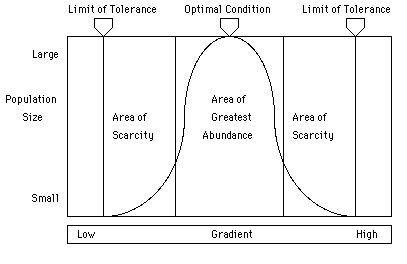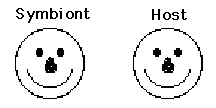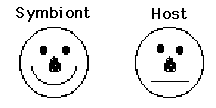Species Interactions
Population
- Definition: A population is a group of individuals of a particular species among which breeding is possible
- All the members of a species in a locale. Ex. All the blue mussels Mytilus edulis on the rocky shores of Palos Verdes California or all the horseshoe crabs Limulus polyphemus of Delaware Bay
Individual
- Definition: An individual is a single organism
- A single member of a species. Ex. A blue mussel Mytilus edulis or a horseshoe crab Limulus polyphemus
Population Dynamics
- Definition: Population dynamics are the changes in populations over time.
- Dynamic changes include population growth and decline.
- Populations can also be stable over time.
- Definition: Stable is constant or unchanging.
Population Growth
- Definition: Population growth is an increase in the numbers of individuals.
- Growth will occur if the numbers of births and immigrants exceeds the numbers of deaths and emigrants.
- Definition: Immigrants are individuals entering a population by moving in from elsewhere
- Definition: Emmigrants are individuals leaving a population by moving eleswhere
Population Decline
- Definition: Population growth is a decrease in the numbers of individuals.
- Decline will occur if the numbers of deaths and emigrants exceeds the numbers of births and immigrants.
Population Models
- Definition: Population models are mathematical formulae that mimic changes in natural populations.
- Exponential growth is a model that mimics growth without limits which occurs in nature when populations are young and have colonized environments that are ideal for their growth or when some limiting factor in the environment has been eliminated.
Population Models
- Definition: Population models are mathematical formulae that mimic changes in natural populations.
Exponential Growth Model
- Exponential growth is a model that mimics growth without limits
- The increase in the number of individuals over a given period of time is equal to the birth rate minus the death rate multiplied by the current number of individuals
- The number of individuals graphed against time yeilds a J-shaped curve
- Growth without limits occurs in nature when populations are young and are located in environments that are ideal for their growth or when some factor limiting their growth has been eliminated
Logistic Growth Model
- Logistic growth is a model of self-limiting growth
- The increase in the number of individuals over a given period of time is equal to the birth rate minus the death rate multiplied by the carrying capacity minus the carrying capacity divided by the current number of individuals
- Definition: Carrying capacity is the maximum number of individuals that the environment can support.
- The number of individuals graphed against time yeilds a S-shaped curve
- Self-limiting growth occurs in nature when populations are older and are located in environments that include factors that resist growth
Population Regulation
- Definition: Population regulation is the control of the number of individuals in a population.
- Regulation is brought about by environmental factors that determine the carrying capacity. It occurs when the severity of environmental resistance is directly related to the number of individuals in the population. Such factors are density dependent.
- Competition for a limited resource, degradation of the environment by metabolic wastes, attacks by predators, and diseases are examples of density dependent environmental factors that determine the carrying capacity.
Environmental Challenges
- Various environmental factors require special efforts by organisms to survive and prosper
- Environmental factors are either abiotic or biotic
- Definition: Abiotic is nonliving (ex. temperature, salinity, pH, light, pressure, dissolved oxygen, currents, tides, waves, exposure to air)
- Definition: Biotic is living (ex. competition, predation, symbiosis)
Habitat
- Definition: The kind of site with respect to biotic and abiotic factors where a species is typically found.
- For example, a coastal ecosystem is divided into rocky shore, mud flat, and oyster reef habitats
- The habitat can be envisioned as the home address of a species and refers to the environment
Microhabitats
- Definition: A microhabitat is a subdivision of a habitat with a unique set of abiotic and biotic factors.
- Describes small scale variations in habitats
Microhabitats vs. Habitats
- Habitats contain many microhabitats occupied by different species.
- Microhabitats contain fewer species. For example, the rocky shore habitat is subdivided into upper surfaces of rocks, under rocks, and tidal pools microhabitats
Ecological Niche
- Definition: An ecological niche is the position of a species in nature defined by all its requirements for survival including food, shelter, competition, predation etc.
- The niche can be envisioned as the ecological definition of a species and refers to the living organisms
Range of Habitats
- The range of habitats and microhabitats occupied by a species is determined by its ability to deal with biotic pressures and to tolerate abiotic extremes
- Each species is able ot tolerate certain environmental conditions and thus will be found where those conditions prevail
Abiotic Gradients
- Definition: An abiotic gradient is a gradual change in an abiotic factor over a distance
- Occurs when one environment blends into another
- Examples: temperature
with latitude, salinity with distance from river mouth, pressure with
depth
Range of Toleration
- Definition: The range of toleration is the range of values of a particular factor within which members of a population can survive.
Optimum Condition
- Definition: The optimum condition is a value of an Abiotic Factor at which the individuals of a population operate best.
- An ideal measure
- If values vary from optimum the health of an organism declines
- Populations have their areas of greatest abundance at positions along a gradient that are close to the optimum condition
Stressful Conditions
- Values of an Abiotic Factor sufficiently distant from the optimum condition to cause a strain on the organism
Limits of Tolerance
- Definition: Limits of tolerance are values of an Abiotic Factor at which the individuals of a population are dying
- Cannot be exceeded without the complete loss of the population
- Populations have their areas of scarcity at positions along a gradient that are close to their limits of tolerance
Effects of Gradients on Species Distributions
- Species have different ranges of toleration with different optimum conditions and limits of tolerance
- Species ranges of toleration are found in different positions along an environmental gradient
- Each species has its own area of greatest abundance where it experiences its optimum conditions
- Each species has its own areas of scarcity where it experiences environmental stress
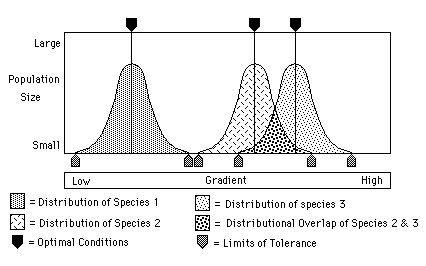
Ranges of Toleration Vary Among Species
- Some species have narrow ranges of tolerance while others have wide ones
- Steno- = narrow
- Eury- = wide
- Thermal (heat), haline (salt), baric (pressure), bathic (depth), topic (place)
- Stenothermal = tolerates only a narrow range of temperature
- Euryhaline = tolerates a wide range of salinity
Geographical Range
- Definition: A geographical range is the overall geographical area occupied by a population or a species.
- Spatial distribution of species on a regional or global scale
Definition of Competition
- Definition: Competition is a struggle for resources that are renewable but limited.
- Definition: Renewable is continuously supplied.
- Definition: Limited is not enough to go around.
- Examples: food, space, light (plants), etc.
Types of Competition
- Definition: Intraspecific competition is between members of same species
- Definition: Interspecific competition is between members of different species
Competitive Exclusion
- Definition: Competitive exclusion the rejection of a species from an area due to its inability to compete with others
- According to Gause's Principle no two species that occupy the same ecological niche can coexist in the same location for long, one will competitively exclude the other.
- Competitive exclusion will occur if one of the competing species produces enough individuals to prevent the population of the other species from expanding into its habitat.
- Competitive exclusion will also occur if one competing species invades the habitat of the other species and successfully eliminates it by monopolizing the limited resources
Competitive Coexistance
- Two species compete but both continue to exist
- The niches of the competing species overlap but do not totally coincide
Resource Partioning
- Definition: Resource partitioning is an adaptive process by which species divide up resources in order to avoid competition.
- Acheived when species specialize and use different portions of a habitat.
- Allows for competitive coexistance
Definition of Symbiosis
- Definition: Symbiosis is two species living together in a close relationship that has evolved over a long period of time.
- Definition: Symbiont is the partner that always benefits from the relationship and is usually the smaller of the two.
- Definition: Host is the partner that may or may not benefit from the relationship and is usually the larger of the two.
Types of Symbiosis
- Mutualism
- Commensalism
- Parasitism
- Endosymbiosis
Mutualism
- Definition: Both species (symbiont and host) benefit from the partnership
Examples of Mutualism
- Cleaner Fish (symbionts) pick parasites off Larger Reef Fish (hosts) that come to cleaners to be groomed
- Anemones (symbionts) live on and are carried about on the shells of Hermit Crabs (hosts) which are protected from predators by the anemones stingers
- Clown Fish (symbionts) live with and are protected by Anemones (hosts) which they in turn feed
- Zooxanthellae (symbionts) live inside and nourishes Coral Polyps (hosts) which provide them with nutrients
- Algae (symbionts) live inside and nourishes Fungi (hosts) which provide them with nutrients (Lichens)
Commensalism
- Definition: One species benefits (symbiont) and the other (host) is neither benefited nor harmed by the partnership
Examples of Commensalism
- Wedding Shrimp (symbionts) live protected inside the cavity of Glass Sponges (hosts)
- Gobies and Pea Crabs (symbionts) live inside the protection of the burrows of Inkeeper Worms (hosts)
Parasitism
- Definition: One species is benefited (parasite symbiont) and the other is harmed (host)
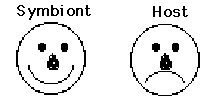
Examples of Parasitism
- Fish Lice (symbionts) suck the blood of Fish (hosts)
- Liver Flukes (symbionts) live inside and consumes the livers of Seals (hosts)
- Tapeworms (symbionts) live in the gut and saps nourishment from Fish (hosts)
Endosymbiosis
- Definition: One species (endosymbiont) lives inside another (host)
Examples of Endosymbiosis
- Zooxanthellae (endosymbionts) live inside and nourishes Coral Polyps (hosts) which provide them with nutrients
- Algae (endosymbionts) live inside and nourishes Fungi (hosts) which provide them with nutrients (Lichens)
- Liver Flukes (endosymbionts) live inside and consumes the livers of Seals (hosts)
- Tapeworms (endosymbionts) live in the gut and saps nourishment from Fish (hosts)
|
Notes
8.2 Ecological
Organization
|

